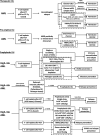Optimization of Donor Lymphocyte Infusion for AML Relapse After Allo-HCT in the Era of New Drugs and Cell Engineering
- PMID: 35155192
- PMCID: PMC8829143
- DOI: 10.3389/fonc.2021.790299
Optimization of Donor Lymphocyte Infusion for AML Relapse After Allo-HCT in the Era of New Drugs and Cell Engineering
Abstract
Donor lymphocyte infusion (DLI) is a key strategy for the treatment of AML relapse after allogeneic hematopoietic cell transplantation (allo-HCT) and has been used for either prophylactic, pre-emptive, or therapeutic purposes. However, the prognosis of these patients remains dismal even after DLI infusion (2-year overall survival, ~25%), and the efficacy is achieved at the cost of toxicities such as graft-versus-host (GVH) disease. Attempts to optimize DLI efficacy and safety, such as dose/timing modification and the use of cytoreduction, before DLI have been performed previously. Recently, a great number of novel targeted and immunomodulatory agents have emerged. Some of them, such as hypomethylating agents, FLT3 and Bcl-2 inhibitors, have been used in combination with DLI, aiming to enhance the graft-versus-leukemia effect. Moreover, manipulation of the DLI graft through cell selection (e.g., donor NK cells) or cell engineering (donor CAR-T cells) has shown potentially superior anti-tumor effects but less GVH effect than conventional DLI in clinical trials. This review summarizes the recent advances on the use of DLI for the prophylaxis/treatment of AML relapse and discusses future strategies which may further improve the treatment efficacy.
Keywords: AML—acute myeloid leukemia; allogeneic hematopoietic cell transplantation; cell engineering; donor lymphocyte infusion (DLI); new drug.
Copyright © 2022 Ye, Yang, Yuan, Huang and Luo.
Conflict of interest statement
The authors declare that the research was conducted in the absence of any commercial or financial relationships that could be construed as a potential conflict of interest.
Figures

Similar articles
-
Treatment of AML Relapse After Allo-HCT.Front Oncol. 2021 Dec 16;11:812207. doi: 10.3389/fonc.2021.812207. eCollection 2021. Front Oncol. 2021. PMID: 34976845 Free PMC article. Review.
-
Repetitively Administered Low-Dose Donor Lymphocyte Infusion for Prevention of Relapse after Allogeneic Stem Cell Transplantation in Patients with High-Risk Acute Leukemia.Cancers (Basel). 2021 May 30;13(11):2699. doi: 10.3390/cancers13112699. Cancers (Basel). 2021. PMID: 34070786 Free PMC article.
-
Immunological and Clinical Impact of Manipulated and Unmanipulated DLI after Allogeneic Stem Cell Transplantation of AML Patients.J Clin Med. 2019 Dec 23;9(1):39. doi: 10.3390/jcm9010039. J Clin Med. 2019. PMID: 31878060 Free PMC article. Review.
-
Comparison of the safety and efficacy of prophylactic donor lymphocyte infusion after haploidentical versus matched-sibling PBSCT in very high-risk acute myeloid leukemia.Ann Hematol. 2019 May;98(5):1267-1277. doi: 10.1007/s00277-019-03636-8. Epub 2019 Feb 12. Ann Hematol. 2019. PMID: 30747249 Clinical Trial.
-
Treatment of relapsed acute leukemia by Ara C plus donor lymphocyte infusion using CD34+ cells reserved at the time of allogeneic transplantation.Blood Cell Ther. 2020 Apr 21;3(2):22-31. doi: 10.31547/bct-2019-015. eCollection 2020 May 25. Blood Cell Ther. 2020. PMID: 37325245 Free PMC article.
Cited by
-
A novel risk model for predicting early relapse in acute myeloid leukemia patients undergoing allogeneic hematopoietic stem-cell transplantation.Bone Marrow Transplant. 2023 Jul;58(7):801-810. doi: 10.1038/s41409-023-01979-5. Epub 2023 Apr 18. Bone Marrow Transplant. 2023. PMID: 37072477
-
Venetoclax is safe and tolerable as post-transplant maintenance therapy for AML patients at high risk for relapse.Bone Marrow Transplant. 2023 Aug;58(8):849-854. doi: 10.1038/s41409-023-01987-5. Epub 2023 Apr 25. Bone Marrow Transplant. 2023. PMID: 37185614
-
Breaking Boundaries: Immunotherapy for Myeloid Malignancies.Cancers (Basel). 2024 Aug 6;16(16):2780. doi: 10.3390/cancers16162780. Cancers (Basel). 2024. PMID: 39199554 Free PMC article. Review.
-
LncRNA SNHG16 regulates RAS and NF-κB pathway-mediated NLRP3 inflammasome activation to aggravate diabetes nephropathy through stabilizing TLR4.Acta Diabetol. 2023 Apr;60(4):563-577. doi: 10.1007/s00592-022-02021-8. Epub 2023 Jan 20. Acta Diabetol. 2023. PMID: 36658449
-
Donor Lymphocyte Infusion in the Treatment of Post-Transplant Relapse of Acute Myeloid Leukemias and Myelodysplastic Syndromes Significantly Improves Overall Survival: A French-Italian Experience of 134 Patients.Cancers (Basel). 2024 Mar 26;16(7):1278. doi: 10.3390/cancers16071278. Cancers (Basel). 2024. PMID: 38610955 Free PMC article.
References
-
- Bazarbachi A, Schmid C, Labopin M, Beelen D, Blau IW, Potter V, et al. . Evaluation of Trends and Prognosis Over Time in Patients With AML Relapsing After Allogeneic Hematopoietic Cell Transplant Reveals Improved Survival for Young Patients in Recent Years. Clin Cancer Res (2020) 26:6475–82. doi: 10.1158/1078-0432.CCR-20-3134 - DOI - PubMed
-
- Kharfan-Dabaja MA, Labopin M, Polge E, Nishihori T, Bazarbachi A, Finke J, et al. . Association of Second Allogeneic Hematopoietic Cell Transplant vs Donor Lymphocyte Infusion With Overall Survival in Patients With Acute Myeloid Leukemia Relapse. JAMA Oncol (2018) 4:1245–53. doi: 10.1001/jamaoncol.2018.2091 - DOI - PMC - PubMed
-
- Schmid C, Labopin M, Nagler A, Bornhäuser M, Finke J, Fassas A, et al. . Donor Lymphocyte Infusion in the Treatment of First Hematological Relapse After Allogeneic Stem-Cell Transplantation in Adults With Acute Myeloid Leukemia: A Retrospective Risk Factors Analysis and Comparison With Other Strategies by the EBMT Acute Leukem. J Clin Oncol (2007) 25:4938–45. doi: 10.1200/JCO.2007.11.6053 - DOI - PubMed
Publication types
LinkOut - more resources
Full Text Sources
Miscellaneous

